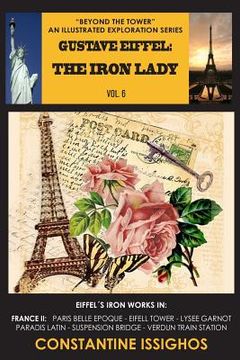Share
Gustave Eiffel: The Iron Lady: The Eiffel Exploration Series
Constantine Issighos
(Author)
·
Nortwater
· Paperback
Gustave Eiffel: The Iron Lady: The Eiffel Exploration Series - Issighos, Constantine
Choose the list to add your product or create one New List
✓ Product added successfully to the Wishlist.
Go to My Wishlists
Origin: U.S.A.
(Import costs included in the price)
It will be shipped from our warehouse between
Monday, August 12 and
Monday, August 19.
You will receive it anywhere in United Kingdom between 1 and 3 business days after shipment.
Synopsis "Gustave Eiffel: The Iron Lady: The Eiffel Exploration Series"
The Eiffel Illustrated Exploration Series is divided in a number of illustrated narrative volumes. Vol. 1 "Beyond the Tower" describes Eiffel's monuments in the USA, Mexico and Ecuador. Vol. 2 "Art of Metal Structures" illustrates Eiffel's iron works in Peru and Chile. Vol. 3 "Genius of Iron Works" presents Eiffel illustrated narrative of Argentina and Bolivia. These 3 volumes completes Eiffel's list of metal structures in the American Continent. All illustrations in this Series were taken by the author himself who traveled in each country and visited every Eiffel's monuments. Vol. 4 "Art and Strength in Architecture" begins to describe the illustrated narrative of Eiffel's iron works in Portugal and Spain. Vol. 5 "The Magician of Iron" presents Eiffel's metal works in Southern-France. Vol. 6 " The Iron Lady" is focused on Eiffel's iron works in the city of Paris including the famous Eiffel Tower, Vol. 7 "Contribution to Belle Epoque" concentrates on Eiffel's monuments in central France, Vol. 8 "Engineer and Scientist" narrates Eiffel's creations and his participation in telecommunications and aerodynamics of his time and Paris most prominent Eiffel works. Aside from the Eiffel Tower, the most familiar feature of Paris is its broad tree-lined boulevards with nearly identical buildings with apartments on the upper floors and shops, cafes and restaurants on the sidewalk level. This urban setting, while very Parisian in setting and some which were designed by Eiffel, is the result of 19th century city planning and inspiration. This period included the Belle Epoque (the Beautiful Era) which lasted until the beginning of WWI in 1914. These six decades (1850's-1914) were characterized by national optimism, the introduction of innovative technology, scientific discoveries in aerodynamics, relative peace and prosperity and the flourishing of the arts, literature, music and theater. Gustave Eiffel's was not the only engineering and architectural company actively participating in the renovation of Paris. Many more must be credited with the construction of public works. When the Haussmann renovation system was implemented in the 1850's, the French government expropriated urban lands which were in the way of the renovation. Thus, Baron Haussmann had the the opportunity of working in the legislative and regulatory context that was adopted specifically for the renovations. The newly rich middle class (nouveau-riche) emerging from the panic of the German-French War of 1871, overlapped the late era of the decadent aristocracy. The celebrations tied to the Exposition Universalle of 1889 indicated the public's nostalgia for the previous several decades and were based largely on the peace and prosperity connected with it in retrospect. French Colonialism was in its prime and Paris became the center of global cultural influence. Its educational, scientific and medical influence including its structural innovations in engineering, were in the leading edge of the western world. Who would have thought that cast-iron and wrought iron of the Industrial Revolution would be used to create a marvelous masterpiece of art like the Eiffel Tower? Gustave Eiffel was able to benefit from from the prosperity of the Belle Epoque and was drawn towards iron structures that were housing a new form of light entertainment and consumerism within the middle-class women of Paris. Cabarets like the 'Cabaret Latin" are landmarks designed by Eiffel in the 1890's and still open for business today became influential in the habits and fads of the city's elite social class, known as the "beautiful people" then known as Tout-Paris or "everyone in Paris."
- 0% (0)
- 0% (0)
- 0% (0)
- 0% (0)
- 0% (0)
All books in our catalog are Original.
The book is written in English.
The binding of this edition is Paperback.
✓ Producto agregado correctamente al carro, Ir a Pagar.

